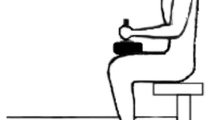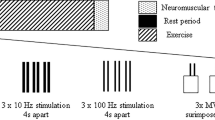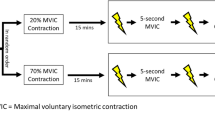Summary
The capacity for twitch potentiation in the gastrocnemius muscle was determined following maximal voluntary contractions (MVC) in 11 elderly (¯x±SD; 66.9±5.3 years) and 12 young (25.7±3.8 years) men. Potentiation was observed by applying selective stimulation to the muscle belly, 2 s after a 5 s MVC. With this procedure, both groups showed significant (P<0.05) increases in twitch tension in the gastrocnemius (ratios of potentiated twitch to baseline were ¯x=1.68±0.40 for young vs ¯x=1.40±0.20 for the elderly,P<0.001). Time to peak tension of the twitch decreased from ¯x=101.5±17.9 ms to ¯x=88.0±15.8 ms in the young men following po tentiation; the respective values for the older men were 136.7±17.9 ms and 133.1±28.6 ms. These changes resulted in a greater rate of tension development in the potentiated state. The elderly gastrocnemius thus showed qualitatively similar changes in the isometric twitch following potentiation, but reduced and prolonged responses in comparison to young adults. Slowed muscle contraction and reduced capacity for potentiation may be physiological correlates of the reported morphological changes in aged skeletal muscle.
Similar content being viewed by others

References
Alway SE, Hughson RL, Green HJ, Patla AE, Frank JS (1987) Twitch potentiation after fatiguing exercise in man. Eur J Appl Physiol 56:461–466
Aniansson A, Hedberg M, Henning G-B, Grimby G (1986) Muscle morphology, enzymatic activity, and muscle strength in elderly men: a follow-up study. Muscle Nerve 9:585–591
Belanger AY, McComas AJ, Elder GBC (1983) Physiological properties of two antagonistic human muscle groups. Eur J Appl Physiol 51:381–393
Bellemare F, Woods JJ, Johansson R, Bigland-Ritchie B (1983) Motor unit discharge rates in maximal voluntary contractions of three human muscles. J Neurophysiol 50:1380–1392
Botelho SY, Cander L (1953) Post-tetanic potentiation before and during ischemia in intact human skeletal muscle. J Appl Physiol 6:221–228
Brown GL, von Euler US (1938) The after effects of a tetanus on mammalian muscle. J Physiol (Lond) 93:39–60
Burke RE (1981) Motor units: anatomy, physiology and functional organization. Handbook of physiology. The nervous system. Am Physiol Soc Bethesda, MD Sect 1, vol 2, chapt. 10, p 345–422
Caccia MR, Morris JB, Johnson MA (1979) Morphology and physiology of skeletal muscle in rodents. Muscle Nerve 2:202–212
Campbell KM, Biggs NL, Blanton PL, Lehr RP (1973) Electromyographic investigation of the relative activity among four components of the triceps surae. Am J Phys Med 52:30–41
Carlsen RC, Walsh DA (1987) Decrease in force potentiation and appearance ofα-adrenergic mediated contracture in aging rat skeletal muscle. Pflügers Arch 408:224–230
Close RI, Hoh JFY (1968) The after-effects of repetitive stimulation on the isometric twitch contraction of rat fast skeletal muscle. J Physiol (Lond) 197:461–477
Cunningham DA, Morrison D, Rice CL, Cooke C (1987) Ageing and isokinetic plantar flexion. Eur J Appl Physiol 56:24–29
Cunningham DA, Rechnitzer PA, Pearce ME, Donner AP (1982) Determinants of self-selected walking pace across ages 19 to 66. J Gerontol 37:560–564
Davies CTM, Mecrow IK, White MJ (1982) Contractile properties of the human triceps surae with some observations on the effects of temperature and exercise. Eur J Appl Physiol 49:255–269
Davies CTM, White MJ, Young K (1983) Electrically evoked and voluntary maximal isometric tension in relation to dynamic muscle performance in elderly male subjects, aged 69 years. Eur J Appl Physiol 51:37–43
Froelich JP, Lakatta EG, Beard E, Spurgeon HA, Weisfeldt ML, Gerstenblith GB (1978) Studies of sarcoplasmic reticulum function and contraction duration in young adult and aged rat myocardium. J Mol Cell Cardiol 10:427–438
Himann JE, Cunningham DA, Rechnitzer PA, Paterson DH (1986) Determinants of choice of walking speed. Can J Appl Sport Sci 11:18P
Houston ME, Green HJ, Stull JT (1985) Myosin light chain phosphorylation and isometric twitch potentiation in intact human muscle. Pflügers Arch 403:348–352
Larsson L (1978) Morphological and functional characteristics of the ageing skeletal muscle in man. A cross-sectional study. Acta Physiol Scand suppl 36:457
Lexell J, Taylor CC, Sjostrom M (1988) What is the cause of the ageing atrophy? J Neurol Sci 84:275–294
MacIntosh BR, Gardiner PF (1987) Posttetanic potentiation and skeletal muscle fatigue: interactions with caffeine. Can J Physiol Pharmacol 65:260–268
McDonagh MJN, White MJ, Davies CTM (1984) Different effects of ageing on the mechanical properties of human arm and leg muscles. Gerontology 30:49–54
Narayanan N, Tucker L (1986) Autonomic interactions in the aging heart: age-associated decrease in cholinergic receptor mediated inhibition ofβ-adrenergic activation of adenylate cyclase. Mech Ageing Dev 34:249–259
Saltin B, Gollnick PD (1983) Skeletal muscle adaptability: significance for metabolism and performance. In: Handbook of Physiology, Sect. 10. American Physiological Society Bethesda, pp 555–631
Takamori ML, Gutmann L, Shane SR (1970) Contractile properties of human skeletal muscle. Arch Neurol 25:535–546
Tomonoga M (1977) Histochemical and ultrastructural changes in senile human skeletal muscle. J Am Geriat Soc 25:125–131
Vandervoort AA, McComas AJ (1983) A comparison of the contractile properties of the human gastrocnemius and soleus muscles. Eur J Appl Physiol 51:435–440
Vandervoort AA, McComas AJ (1986) Contractile changes in opposing muscles of the human ankle joint with aging. J Appl Physiol 61:361–367
Vandervoort AA, Quinlan J, McComas AJ (1983) Twitch potentiation after voluntary contraction. Exp Neurol 81:141–152
Author information
Authors and Affiliations
Rights and permissions
About this article
Cite this article
Petrella, R.J., Cunningham, D.A., Vandervoort, A.A. et al. Comparison of twitch potentiation in the gastrocnemius of young and elderly men. Europ. J. Appl. Physiol. 58, 395–399 (1989). https://doi.org/10.1007/BF00643515
Accepted:
Issue Date:
DOI: https://doi.org/10.1007/BF00643515



